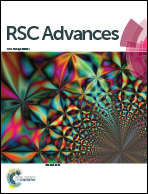Corrosion inhibition of carboxylate inhibitors with different alkylene chain lengths on carbon steel in an alkaline solution
Abstract
The inhibition effects of five organic carboxylate compounds with different alkylene chain lengths on Q235 steel in a simulated carbonation concrete pore solution (pH 11.5) were studied using quantum chemical calculations, electrochemical measurement and surface analysis. The results show that the adsorption capacity of the inhibitors increases with increasing distance between the C![[double bond, length as m-dash]](https://www.rsc.org/images/entities/char_e001.gif) C bond and COO– group. As the alkylene chain length increases, the absolute surface charge value increases and the inhibition effectiveness tends to increase. C11 shows the best inhibition. The carboxylate inhibitors adsorb on a steel surface by forming Fe–OOC–Cx compounds and the C
C bond and COO– group. As the alkylene chain length increases, the absolute surface charge value increases and the inhibition effectiveness tends to increase. C11 shows the best inhibition. The carboxylate inhibitors adsorb on a steel surface by forming Fe–OOC–Cx compounds and the C![[double bond, length as m-dash]](https://www.rsc.org/images/entities/char_e001.gif) C bonds could enhance the adsorption process.
C bonds could enhance the adsorption process.



 Please wait while we load your content...
Please wait while we load your content...